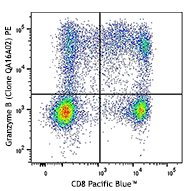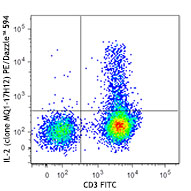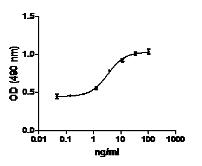- Regulatory Status
- RUO
- Other Names
- Insulin-like growth factor I, somatomedin C, Nonsuppressible insulin-like activity I (NSILA-I)
- Ave. Rating
- Submit a Review
- Product Citations
- publications

-

Recombinant human IGF-I induces the proliferation of MCF-7 human breast adenocarcinoma cell line in a dose dependent manner. BioLegend’s protein was compared side-by-side to the leading competitor’s equivalent product.
| Cat # | Size | Price | Quantity Check Availability | Save | ||
|---|---|---|---|---|---|---|
| 590904 | 25 µg | £70 | ||||
IGF-I (insulin-like growth factor 1), initially described in 1957, is a hormone that is important in childhood growth and also has anabolic effects in adults. It is a member of the IGF family that is comprised of three members: IGF-I, IGF-II, and insulin. IGF-I and IGF-II share approximately 50% similarity with insulin at the amino acid level. Human IGF-I is synthesized as a 191 amino acid prepro-IGF-I; pro-IGF-I is processed to the mature, active protein, and this procedure requires glucose regulating protein 94 (GRP94) that possesses chaperone activity towards IGF-I. Deletion of muscle GRP94 impairs muscle and body growth by inhibiting local production of IGF proteins. Seven binding proteins have been described (IGFBP-1 to -7). IGFBPs extend the half life and regulate the availability of IGF-I and IGF-II. It has been described that IGFBP3 is the main circulating binding protein for IGFs; in serum approximately 75% of circulating IGF-I and IGF-II bind to IGFBP3 and the co-carrier acid labile subunit (ALS). IGF-I binds to three receptors, and the binding to IGFIR promotes cell proliferation, survival, differentiation, and migration. IGF-I deficiency is associated to growth hormone insensitivity syndrome (GHIS) also called Laron syndrome, liver cirrhosis, age-related cardiovascular and neurological diseases, and intrauterine growth restriction.
Product DetailsProduct Details
- Source
- Human IGF-I, amino acids Gly49-Ala118 (Accession# p056019) was expressed in E. coli.
- Molecular Mass
- The 70 amino acid recombinant protein has a predicted molecular mass of approximately 7.6 kD. The DTT-reduced and non-reduced protein migrate at approximately 11 kD by SDS-PAGE. The N-terminal amino acid is Gly.
- Purity
- >95%, as determined by Coomassie stained SDS-PAGE.
- Formulation
- 0.22 µm filtered protein solution is in 300 mM ammonium acetate pH 5.5.
- Endotoxin Level
- Less than 0.1 EU per µg protein as determined by the LAL method.
- Concentration
- 10 and 25 µg sizes are bottled at 200 µg/mL. 100 µg size and larger sizes are lot-specific and bottled at the concentration indicated on the vial. To obtain lot-specific concentration and expiration, please enter the lot number in our Certificate of Analysis online tool.
- Storage & Handling
- Unopened vial can be stored between 2°C and 8°C for up to 2 weeks, at -20°C for up to six months, or at -70°C or colder until the expiration date. For maximum results, quick spin vial prior to opening. The protein can be aliquoted and stored at -20°C or colder. Stock solutions can also be prepared at 50 - 100 µg/mL in appropriate sterile buffer, carrier protein such as 0.2 - 1% BSA or HSA can be added when preparing the stock solution. Aliquots can be stored between 2°C and 8°C for up to one week and stored at -20°C or colder for up to 3 months. Avoid repeated freeze/thaw cycles.
- Activity
- ED50 = 1.5 - 7.5 ng/ml, as determined by the dose dependent stimulation of MCF-7 cell proliferation.
- Application
-
Bioassay
- Application Notes
-
BioLegend carrier-free recombinant proteins provided in liquid format are shipped on blue-ice. Our comparison testing data indicates that when handled and stored as recommended, the liquid format has equal or better stability and shelf-life compared to commercially available lyophilized proteins after reconstitution. Our liquid proteins are verified in-house to maintain activity after shipping on blue ice and are backed by our 100% satisfaction guarantee. If you have any concerns, contact us at tech@biolegend.com.
- Product Citations
-
Antigen Details
- Distribution
-
Astrocytes, hepatocytes, microglia, intestinal smooth muscle, myoblast, NK cells.
- Function
- IGF-I induces mitogenesis, proliferation, growth, differentiation, and angiogenesis. IGF-I is a mediator of growth hormone action. IGF-I is involved in neuronal myoblast proliferation and differentiation, and organ development. IGF-I promotes NK cell development and cytotoxic activity in NK cells.
- Interaction
- Neuronal cells, myoblast, T cells, B cells, NK cells.
- Ligand/Receptor
- IGF-I receptor, Insulin receptor isoform A, and IGF-II receptor (M-6-P-R).
- Cell Type
- Embryonic Stem Cells, Hematopoietic stem and progenitors, Mesenchymal Stem Cells, Neural Stem Cells
- Biology Area
- Cell Biology, Signal Transduction, Stem Cells
- Molecular Family
- Cytokines/Chemokines, Growth Factors
- Antigen References
-
1. Bell GI, et al. 1984. Nature 310:775.
2. Karey KP and Sirbasku DA, 1988. Cancer Res. 48:4083.
3. Mohan S and Baylink DJ, 2002. J. Endocrinol. 175:19.
4. Ostrovsky O, et al. 2010. Biochim. Biophys. Acta. 1803:333.
5. Barton ER, et al. 2012. FASEB. J. 26:3691.
6. Puche JE and Castilla-Cortázar I. 2012. J. Transl. Med. 10:224.
7. Ni F, et al. 2013. Nat. Commun. 4:1479. - Gene ID
- 3479 View all products for this Gene ID
- UniProt
- View information about IGF-I on UniProt.org
Related FAQs
- Why choose BioLegend recombinant proteins?
-
• Each lot of product is quality-tested for bioactivity as indicated on the data sheet.
• Greater than 95% Purity or higher, tested on every lot of product.
• 100% Satisfaction Guarantee for quality performance, stability, and consistency.
• Ready-to-use liquid format saves time and reduces challenges associated with reconstitution.
• Bulk and customization available. Contact us.
• Learn more about our Recombinant Proteins. - How does the activity of your recombinant proteins compare to competitors?
-
We quality control each and every lot of recombinant protein. Not only do we check its bioactivity, but we also compare it against other commercially available recombinant proteins. We make sure each recombinant protein’s activity is at least as good as or better than the competition’s. In order to provide you with the best possible product, we ensure that our testing process is rigorous and thorough. If you’re curious and eager to make the switch to BioLegend recombinants, contact your sales representative today!
- What is the specific activity or ED50 of my recombinant protein?
-
The specific activity range of the protein is indicated on the product datasheets. Because the exact activity values on a per unit basis can largely fluctuate depending on a number of factors, including the nature of the assay, cell density, age of cells/passage number, culture media used, and end user technique, the specific activity is best defined as a range and we guarantee the specific activity of all our lots will be within the range indicated on the datasheet. Please note this only applies to recombinants labeled for use in bioassays. ELISA standard recombinant proteins are not recommended for bioassay usage as they are not tested for these applications.
- Have your recombinants been tested for stability?
-
Our testing shows that the recombinant proteins are able to withstand room temperature for a week without losing activity. In addition the recombinant proteins were also found to withstand four cycles of freeze and thaw without losing activity.
- Does specific activity of a recombinant protein vary between lots?
-
Specific activity will vary for each lot and for the type of experiment that is done to validate it, but all passed lots will have activity within the established ED50 range for the product and we guarantee that our products will have lot-to-lot consistency. Please conduct an experiment-specific validation to find the optimal ED50 for your system.
- How do you convert activity as an ED50 in ng/ml to a specific activity in Units/mg?
-
Use formula Specific activity (Units/mg) = 10^6/ ED50 (ng/mL)
 Login / Register
Login / Register 














Follow Us